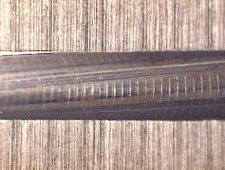Home | Glossary | Resources | Help | Contact Us | Course Map
Archival Notice
This is an archive page that is no longer being updated. It may contain outdated information and links may no longer function as originally intended.
Broaching uses multiple cutting surfaces (cutters) mounted on the same axis to progressively remove metal. It is used for critical operations where precise angle or depth control must be maintained. After the first cutter, each successive cutter is a few ten-thousandths larger than the one before it. Each cutter shaves off a small amount of metal, reducing the applied force.
Most firearm examiners will recognize the word broaching from its use in the manufacture of rifled gun barrels. Broaching is one way to produce the spiral grooves needed to spin-stabilize a bullet. A rifling broach has circular working nodes, each with a reverse profile of the rifling pattern. As the broach moves through the barrel, each node shaves off a little metal. The next node is slightly larger and rotated from the previous node to match the desired rifling twist. Broached barrels made with quality tooling have very straight bores and are capable of fine accuracy.
Additional Online Courses
- What Every First Responding Officer Should Know About DNA Evidence
- Collecting DNA Evidence at Property Crime Scenes
- DNA – A Prosecutor’s Practice Notebook
- Crime Scene and DNA Basics
- Laboratory Safety Programs
- DNA Amplification
- Population Genetics and Statistics
- Non-STR DNA Markers: SNPs, Y-STRs, LCN and mtDNA
- Firearms Examiner Training
- Forensic DNA Education for Law Enforcement Decisionmakers
- What Every Investigator and Evidence Technician Should Know About DNA Evidence
- Principles of Forensic DNA for Officers of the Court
- Law 101: Legal Guide for the Forensic Expert
- Laboratory Orientation and Testing of Body Fluids and Tissues
- DNA Extraction and Quantitation
- STR Data Analysis and Interpretation
- Communication Skills, Report Writing, and Courtroom Testimony
- Español for Law Enforcement
- Amplified DNA Product Separation for Forensic Analysts



